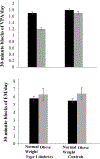Physical activity and electronic media use in the SEARCH for diabetes in youth case-control study
- PMID: 20457683
- PMCID: PMC7859967
- DOI: 10.1542/peds.2009-1598
Physical activity and electronic media use in the SEARCH for diabetes in youth case-control study
Abstract
Objective: The aim of this study was to characterize the physical activity (PA) and electronic media (EM) use habits of a population-based, ascertained sample of youths with diabetes mellitus (DM).
Methods: For this investigation, the Search for Diabetes in Youth Case-Control study (age: 10-20 y; 55% female) recruited 384 youths with provider-diagnosed type 1 DM, 90 youths with type 2 DM, and 173 healthy control subjects between 2003 and 2006, in 2 US centers. PA and EM use were assessed with a 3-day recall of activities, in 30-minute time blocks. Adherence to current recommendations was determined as a report of > or = 2 blocks of moderate/vigorous PA per day and <4 blocks of EM use per day. Differences in PA and EM use for DM/control groups were assessed with adjustment for age, study site, and race/ethnicity.
Results: Male subjects with type 2 DM reported lower levels of vigorous PA than did control subjects (1.1 vs 2.3 blocks; P < .05). Compliance with the moderate/vigorous PA recommendation among youths with type 2 DM was lower (68.3%), compared with youths with type 1 DM (81.7%; odds ratio: 0.51 [95% confidence interval: 0.26-1.00]; P = .047) and control subjects (80.4%; odds ratio: 0.48 [95% confidence interval: 0.23-1.02]; P = .05). Rates of compliance with EM use recommendations ranged from 29.5% to 49.1%.
Conclusion: In this study, large proportions of youths with DM, especially type 2 DM, failed to meet PA and EM use recommendations.
Figures


Similar articles
-
Electronic media exposure and its association with activity-related outcomes in female adolescents: cross-sectional and longitudinal analyses.J Phys Act Health. 2009 Mar;6(2):137-43. doi: 10.1123/jpah.6.2.137. J Phys Act Health. 2009. PMID: 19420390
-
Type 2 diabetes in youth: a phenotype of poor cardiorespiratory fitness and low physical activity.Int J Pediatr Obes. 2009;4(4):332-7. doi: 10.3109/17477160902923341. Int J Pediatr Obes. 2009. PMID: 19922049 Free PMC article.
-
Prevalence and correlates of screen-based media use among youths with autism spectrum disorders.J Autism Dev Disord. 2012 Aug;42(8):1757-67. doi: 10.1007/s10803-011-1413-8. J Autism Dev Disord. 2012. PMID: 22160370 Free PMC article.
-
Updating the evidence on physical activity and health in women.Am J Prev Med. 2007 Nov;33(5):404-411. doi: 10.1016/j.amepre.2007.07.029. Am J Prev Med. 2007. PMID: 17950406 Review.
-
Screen Time and Health Indicators Among Children and Youth: Current Evidence, Limitations and Future Directions.Appl Health Econ Health Policy. 2017 Jun;15(3):323-331. doi: 10.1007/s40258-016-0289-3. Appl Health Econ Health Policy. 2017. PMID: 27798796 Review.
Cited by
-
Hypoglycaemia avoidance behaviour and exercise levels in active youth with type 1 diabetes.Endocrinol Diabetes Metab. 2020 May 30;3(3):e00153. doi: 10.1002/edm2.153. eCollection 2020 Jul. Endocrinol Diabetes Metab. 2020. PMID: 32704571 Free PMC article.
-
Longitudinal association between eating frequency and hemoglobin A1c and serum lipids in diabetes in the SEARCH for Diabetes in Youth study.Pediatr Diabetes. 2018 Apr 30:10.1111/pedi.12690. doi: 10.1111/pedi.12690. Online ahead of print. Pediatr Diabetes. 2018. PMID: 29708292 Free PMC article.
-
Physical activity and self-concept: the SEARCH for diabetes in youth case control study.Pediatr Exerc Sci. 2012 Nov;24(4):577-88. doi: 10.1123/pes.24.4.577. Pediatr Exerc Sci. 2012. PMID: 23196765 Free PMC article.
-
Adherence and renal biopsy feasibility in the Renin Angiotensin-System Study (RASS) primary prevention diabetes trial.Diabetes Res Clin Pract. 2013 Oct;102(1):25-34. doi: 10.1016/j.diabres.2013.06.004. Epub 2013 Sep 17. Diabetes Res Clin Pract. 2013. PMID: 24050942 Free PMC article. Clinical Trial.
-
Outpatient assessment of determinants of glucose excursions in adolescents with type 1 diabetes: proof of concept.Diabetes Technol Ther. 2012 Aug;14(8):658-64. doi: 10.1089/dia.2012.0053. Diabetes Technol Ther. 2012. PMID: 22853720 Free PMC article.
References
-
- Liese AD, D’Agostino RB Jr., Hamman RF, et al. The burden of diabetes mellitus among US youth: prevalence estimates from the SEARCH for Diabetes in Youth Study. Pediatrics. 2006;118(4):1510–1518. - PubMed
-
- American Diabetes Association. Economic costs of diabetes in the US in 2007. Diabetes Care. 2008;31(3):596–615 - PubMed
-
- Centers for Disease Control and Prevention. Racial disparities in diabetes mortality among persons aged 1–19 years: United States, 1979 –2004. MMWR Morb Mortal Wkly Rep. 2007;56(45):1184–1187 - PubMed
-
- National Diabetes Data Group. Diabetes in America. Bethesda, MD: National Institute of Diabetes and Digestive and Kidney Diseases; 1995
-
- Sawyer MG, Reynolds KE, Couper JJ, et al. Health-related quality of life of children and adolescents with chronic illness--a two year prospective study. Qual Life Res. 2004;13(7):1309–1319. - PubMed
Publication types
MeSH terms
Grants and funding
LinkOut - more resources
Full Text Sources
Medical

